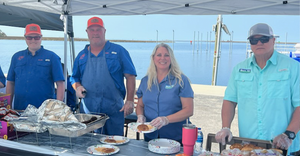One Energy Launches Largest U.S. Truck Charging Site
Industrial power company One Energy is trying to make it easier for fleets to align all the moving parts, and to help them get started even before they commit to transitioning to electric. The company, most known for its wind and solar installations for industrial energy users, built a 30-MW semitruck charging site in Findlay, Ohio.

Figuring out how to electrify heavy-duty trucking at scale is a complex job that’s yet to near the finish line. These work horses run long hours and consume a lot of power, presenting a twofold challenge—designing beefy battery-operated trucks and building out enough readily accessible charging infrastructure to keep those trucks running. Industry experts have this advice for fleet operators ready to test early options: be sure to coordinate both vehicle purchases and fleet-specific charging infrastructure at the same time. But that’s easier said than done as still fairly nascent technology evolves.
Industrial power company One Energy is trying to make it easier for fleets to align all the moving parts, and to help them get started even before they commit to transitioning to electric. The company, most known for its wind and solar installations for industrial energy users, built a 30-MW semitruck charging site in Findlay, Ohio, with a 138,000-volt transmission line that’s ready to go, says Jereme Kent, One Energy CEO. It’s reportedly the largest truck charging site in the U.S. in terms of capacity.
“We just need to know what chargers customers want. Then we can set up ‘Power Islands’ [allowing corporate customers to customize charging operations and equipment to their specific needs] in weeks or months,” he says.
But Kent and his team fast realized a barrier to moving the electric needle: a lack of good test programs where potential end users can learn about the products out there.
So, One Energy is inviting trucking operations to take Class 8 electric semis on the road for free. The company leases the vehicles from OEMs on its own dime and provides the power.
By now a backlog of fleet operators are waiting to try the trucks, with their choices being an Orange EV semi shuttle truck and a Daimler eCascadia semi, which is a day cab.
Northwest, Ohio-based Garner Trucking runs 100 trucks, each that travel about 2,500 miles a week to support retail distribution.
Garner President and CEO Sherri Garner Brumbaugh signed up for the pilot to get an idea of whether her traditional over the road trucking company could operate an EV in its fleet.
Having just completed a pilot on an Orange EV spotter truck Garner Brumbaugh has learned the vehicle could only travel 25 MPH, but she is ready to see how an eCascadia will work—a vehicle that lists for approximately $430,000 while it’s diesel counterpart is about $160,000.
So, one of her questions is what is the return on investment? She’s wondering if she can get a longer contract with a customer to spread the equipment cost over a longer window.
“I want to know, how does the truck perform over a longer period of time? Will I have to replace the batteries? If I get held up, can I find a place to charge the truck?
“These are just a few burning questions. I’m sure there will be more, but I want to pilot these trucks so I can share with my peers and the industry my experience,” Garner Brumbaugh says.
She’s gone into this trial with an open mind hoping for good outcomes.
“I’m thankful for One Energy and their willingness to offer a truck/s to pilot. It is a forward-thinking concept. More fleets need to try. We all operate our trucks differently.”
As the industry evolves One Energy plans to be ready with equipment that works broadly and still allow for customization. That’s why the team decided to build the power infrastructure, then wait for customers to tell them what charger to build for their needs.
While trusting in the “If you build it they will come” mantra may seem like a bold move, One Energy is not putting all its eggs in one basket at this early juncture. Rather it’s courting other companies with varied high-energy needs. Its first tenants are bit coin mining companies, and Kent referenced mobile data centers and hydrogen producers among candidates.
“This strategy gives us a reason to build a site now rather than wait until there are enough electric semis on the road. It’s how we can justify the expense, hoping in the long run to service primarily electric semitruck fleets,” he says.
One Energy has the ability to expand from its current 30 MW to 150 MW, enough to fast charge more than 450 trucks at one time.
With its cheap power, relatively low-cost land, and thriving trucking industry, the Midwest is as good a place as any to kickstart charging infrastructure. Kent sees Findlay, Ohio in particular as a solid market fit. Located 30 minutes south of I-90, which runs east–west across northern Ohio, it’s home to dozens of distribution centers that support thousands of trucks daily, mostly out and back and regional routes that return to a home base where they can be recharged overnight.
“Our state boasts some of the most competitive power costs in the world and a robust high-voltage transmission infrastructure. Unlike some states, we don't need to wait years or rely on mandates and subsidies to advance the electrification of logistics. This site is a testament to that fact,” says Dana Saucier, head of Economic Development for JobsOhio.
From his perch, Kent sees that curious parties want to understand the most cost-effective way to transition and if it’s worth it to make the move yet.
“Anecdotally they want to be sure they don’t miss a possible chance to become more competitive in the long run,” he says.
“We are also seeing when a fleet operator asks a brand they truck for, what if we did this route with an all-electric vehicle and you got emissions credit, that puts [fleets] at the front. Companies doing the trials are hearing from their customers that they are interested in ultra-low carbon logistics.”
About the Author
You May Also Like




